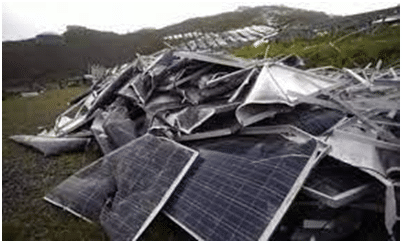Solar Waste Handling in India
Why in the news:
- While India ramps up its solar power installation, it does not yet have a firm policy on managing waste that results from used solar panels or from the manufacturing process.
- The International Renewable Energy Agency (IRENA) last December estimated that the global photovoltaic waste will touch 78 million tonnes by 2050, with India expected to be one of the top five photovoltaic-waste creators.
Solar waste in india:
- Solar waste — the electronic waste generated by discarded solar panels — is sold as scrap in the country. It can increase by at least four-five-fold by the next decade. India should focus its attention on drafting comprehensive rules to deal with solar waste
- India currently considers solar waste a part of electronic waste and does not account for it separately, according to a response to a question in the Rajya Sabha.
- However, said Minister for New and Renewable Energy (MNRE) R.K. Singh, a committee had been constituted under the chairmanship of the Ministry’s Secretary to propose an action plan to evolve a “circular economy” in solar panel, through reuse/recycling of waste generated.
- There was no commercial raw material recovery facility for solar e-waste operational in India, but a pilot facility for solar panel recycling and material recovery had been set up by a private company in Gummidipoondi, Chennai, Tamil Nadu.

Solar panel’s life
- India has set a target of producing 100 GW of solar energy by 2022.
- The cumulative capacity of grid-connected solar photovoltaic (PV) installations is around 40 GW and of the current capacity, about 35.6 GW, is generated from ground-mounted plants and 4.4 GW from rooftop solar. A gigawatt is a 1,000 megawatt.
- Solar panels have an estimated life of 25 years, and given that India’s solar manufacturing industry took off around 2010 most of the installed systems were new and early in their calendar life cycle and therefore unlikely to generate a large quantity of solar waste.
- That, however, is only partially accurate, according to the Council for Energy, Environment and Water, a Delhi based think-tank.
- End-of-life was only one of the possible waste streams for PV modules and there were several other stages where modules could get damaged and were discarded, especially during transportation and installation.
- Additionally, modules could develop defects during the plant operations and be discarded even before their scheduled life span.
Cumulative waste
- Despite its ambitious expansion plans, much of India’s solar PV manufacturing uses imported components with parts mostly sourced from China. India now has a manufacturing capacity of 3GW for solar cells and 15GW for modules and, in the Budget this month, had announced a basic customs duty of 40% on modules and 25% on solar cell imports from April 1.
- In the CEEW’s reckoning, PV modules had so far likely generated a cumulative waste of nearly 285,000 tonnes, as of FY21, from the early-life loss of the installed 40 GW grid-connected solar capacity. “Hence, it will be imprudent to ignore and delay the issue of PV waste management anymore,” say CEEW analysts Akanksha Tyagi and Neeraj Kuldeep, in a report.
- India currently considers solar waste a part of electronic waste and does not account for it separately, according to a response to a question in the Rajya Sabha
- While India ramps up its solar power installation, it does not yet have a firm policy on managing waste that results from used solar panels or from the manufacturing process
- Despite its ambitious expansion plans, much of India’s solar PV manufacturing uses imported components with parts mostly sourced from China
How are other countries handling solar waste?
- The EU is clearly ahead of other regions in terms of framing and implementing waste management policies for PV waste. The Waste Electrical and Electronic Equipment (WEEE) Directive of the EU imposes responsibility for the disposal of waste on the manufacturers or distributors who introduce or install such equipment for the first time.
- PV manufacturers are solely responsible for the collection, handling and treatment of modules at the end of their lifecycle, according to the WEEE Directive.
- Currently, most of the EU member states have come up with directives for collecting, handling and management of PV waste.
- The UK also has an industry-managed “take-back and recycling scheme”, where all PV producers will need to register and submit data related to products used for the residential solar market (B2C) and non-residential market.
- While there are no federal statutes or regulations in the United States that talk about recycling, there are some states who have proactively defined policies to address end-of-life PV module management.
- Washington and California have come up with extended producer responsibility (EPR) regulations. Washington now requires PV module manufacturers to finance the take-back and reuse or recycling of PV modules sold within or into the state at no cost to the end-user.
- In addition, New Jersey and North Carolina passed legislation in 2019 to study and explore PV module management options that can help in forming future legislations.
The federal government In Australia has acknowledged the concern and announced $2 million grant as part of the National Product Stewardship Investment Fund to develop and implement an industry-led product stewardship scheme for PV systems. - It is expected that the scheme will encourage shared responsibility throughout the supply chain to manage the impacts of PV modules through their life cycle and support the development of an efficient and innovative domestic PV recycling industry.
- Countries such as Japan and South Korea have already indicated their resolve to come up with dedicated legislation to address the PV waste problem.
- India needs a three-pronged approach to handle the mammoth quantum of PV waste it will generate in the next 10 years.
Subscribe
0 Comments





